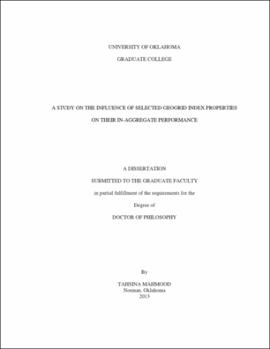| dc.contributor.advisor | Hatami, Kianoosh | |
| dc.creator | Mahmood, Tahsina | |
| dc.date.accessioned | 2019-04-27T21:41:00Z | |
| dc.date.available | 2019-04-27T21:41:00Z | |
| dc.date.issued | 2013 | |
| dc.identifier | 9985164102042 | |
| dc.identifier.uri | https://hdl.handle.net/11244/319336 | |
| dc.description.abstract | Geogrids are polymer-based products which are commonly used to reinforce soil walls, steep slopes and roadway bases. Inclusion of geogrids as aggregate base reinforcement, with proper installation, has been shown to result in increased stiffness and service life of flexible pavements. It also results in reduced distress and deformations, improved performance and hence, reduced repair and maintenance costs of pavements. The relationship between the in-isolation and in-aggregate properties of a geogrid depends on several factors including the geogrid and aggregate properties, their frictional and interlocking interaction mechanisms and the overburden pressure. | |
| dc.description.abstract | However, the influence of individual index properties of geogrids on their in-aggregate performance is still not well understood and requires further study. Currently, there is a lack of: 1) a universally accepted design methodology that would incorporate in-isolation material properties of geogrids for base aggregate reinforcement and subgrade stabilization applications, and 2) agreement as to which geogrid properties are most relevant to their in-aggregate performance. This is particularly important as new geogrids and manufacturing processes are introduced in the market on a continuous basis. | |
| dc.description.abstract | Realizing the need for further research in this area, the influence of selected index properties of geogrids on their in-aggregate performance is examined in this study. A series of in-isolation and large-scale in-aggregate (i.e. pullout, installation damage and cyclic plate load) tests was carried out on selected geogrid products in ODOT Type-A aggregate, which is a dense-graded aggregate commonly used in Oklahoma Department of Transportation (ODOT) projects. The in-isolation properties studied included the geogrids low-strain (i.e. 2% and 5% strain) and ultimate rib strength, and their junction strength in both machine (MD) and cross-machine (XD) directions. The geogrids investigated in the study were classified in two basic categories of extruded (EGG) and non-extruded (NEGG) geogrids. The latter category primarily included the woven and knitted geogrid products. | |
| dc.description.abstract | Results of the study indicated that for both categories of extruded (EGG) and non-extruded (NEGG) geogrids examined, greater rib and junction strength properties overall resulted in greater pullout resistance. Geogrids junction strength and low-strain rib strength showed a reasonably strong correlation with their pullout performance regardless of the geogrid category examined. The rib strength at 2% strain showed a stronger correlation than the 5%-strain strength with the geogrid pullout performance. However, ultimate rib strength of geogrid showed convincing correlations with their pullout performance only when they were examined in separate categories with respect to their manufacturing technique (i.e. when the EGG and NEGG geogrids were examined as separate categories). The installation damage test results revealed that reduction factors for rib strength values at 2% strain were significant. Partial reduction factors for installation damage for the EGG products were generally found to be larger than those for the NEGG products. Cyclic plate load test results indicated that the Strength Reduction Factor (SRF)) and Traffic Benefit Ratio (TBR) values of the test models were proportional to the rib strengths of the geogrid reinforcement. However, the SRF and TBR values in either of the EGG or NEGG geogrid categories did not show a convincing dependence on their ultimate junction strength. A set of equations were developed to calculate a predicted TBR value for the reinforced aggregate-subgrade models with EGG and NEGG products as separate categories. The findings of this study are beneficial in relating the in-isolation properties of geogrids to their in-aggregate performance. | |
| dc.format.extent | 323 pages | |
| dc.format.medium | application.pdf | |
| dc.language | en_US | |
| dc.relation.requires | Adobe Acrobat Reader | |
| dc.subject | Geogrids | |
| dc.subject | Aggregates (Building materials) | |
| dc.title | A STUDY ON THE INFLUENCE OF SELECTED GEOGRID INDEX PROPERTIES ON THEIR IN-AGGREGATE PERFORMANCE | |
| dc.type | text | |
| dc.type | document | |
| dc.thesis.degree | Ph.D. | |
| ou.group | College of Engineering::School of Civil Engineering and Environmental Science | |
